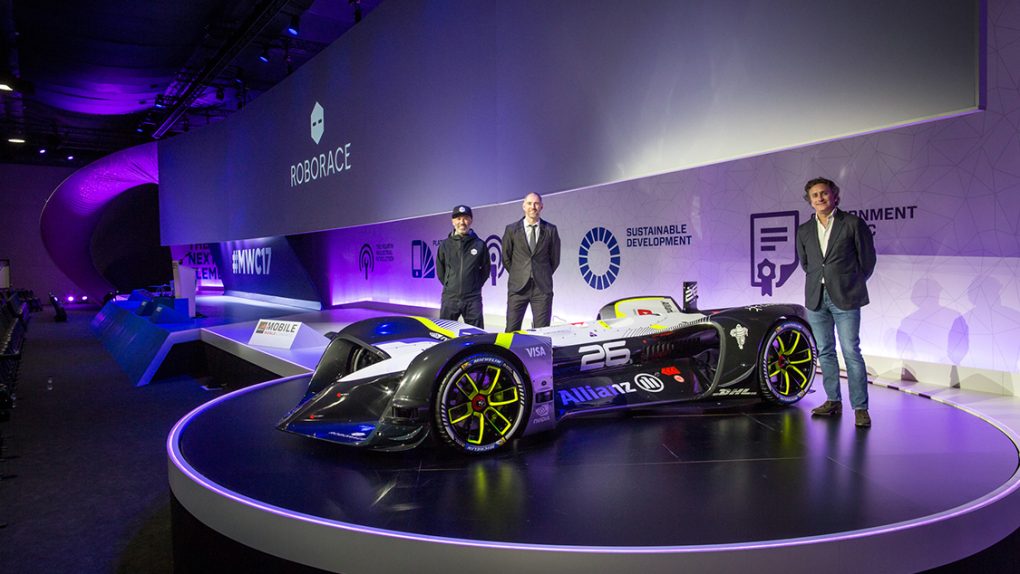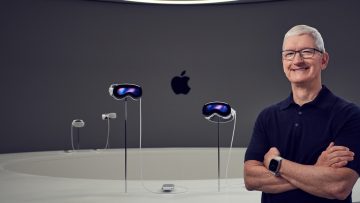With its swooping lines, the wing-like arches over the wheels, and its overall low, sleek design, the Robocar unveiled at this year’s Mobile World Congress looks striking enough that it might seem just as suitable for a sci-fi movie set as it does a race track.
Which is understandable, given that the designer of the self-driving electric racing car from the company Roborace is Daniel Simon, an automotive futurist who’s worked on hit sci-fi flicks like Tron: Legacy and Oblivion. Simon has also worked at Volkswagen, as a senior designer at Bugatti and during his career has designed everything from drones to motorcycles, spaceships and Le Mans cars.
And then there’s his Robocar, which is — to say the least — something else entirely.
This is a car designed without the constraints of human safety and with a focus on beauty. It can hit a top speed of 199 mph. It’s also kitted out with features like four motors, a 540 kilowatt battery and is made mostly of carbon fiber.
The tech under the hood includes 5 LiDAR sensors, two radars, 18 ultrasonic sensors, two optical speed sensors, and is among other things powered by Nvidia’s Drive PX2 brain, capable of a whopping 24 trillion AI operations per second. The car, according to the company, also relies on deep learning for 360-degree situational awareness around the car as it figures out an efficient, safe driving trajectory.
The Robocar, to be sure, still has a way to go. There won’t be any full Robo-races taking place anytime soon. But Roborace CTO Bryn Balcombe tells BGR progress is continuing. For starters? “The car will appear on Formula E tracks during the remainder of the season taking part in demonstrations that showcase the capabilities of the technology. The Robocar will be the standard vehicle that all teams use to ensure that the hardware is standardised and that the focus for development is on the software.”
Taking a step back — what’s the point of all this? Why a self-driving race car? Why bring in a designer with Hollywood chops?
Balcombe spoke with BGR about the company’s motivations, where it sees this technology headed, why it gave Simon what Balcombe described as a “blank canvas” creatively — and what the future holds, both for the company and its signature vehicle, as well as for self-driving technology itself.
For starters, the idea here is bigger than development of an autonomous racing car alone. “Denis Sverdlov, Roborace CEO and Alejandro Agag, Formula E CEO, realized that there was an opportunity to progress the development of driverless technology in a competitive and extreme environment,” Balcombe said. “The series is in existence to progress the technology at a faster rate and give the general public a chance to see the technology in action so that they feel more comfortable with the idea of having it on our roads in the near future.”
So it’s as much about making a statement as it is about helping self-driving tech progress and reach mass acceptance. If Roborace can help show how self-driving technology can react well under extreme circumstances and high speeds, in other words, the public will have more confidence in the tech working at slower speeds away from a race track, on, say, normal city streets.
The Robocar design was revealed in March 2016. That’s also around the time Roborace announced its work with Simon.
At the time, Simon enthused that his work with Roborace combined all his big passions into one job — motor racing, design and advanced technologies. And he’s been working with racing engineers and aerodynamicists from the start.
The other piece of this is Roborace’s creation of its DevBot, which is a kind of testing car with all the same tech as the Robocar, including the same drivetrain, sensors, computing systems and communications technology. Teams will use the DevBot cars to develop their own algorithms to control the Robocars they’ll apply to drive in Roborace competitions.
The whole thing, in other words, is fun, futuristic — and a kind of Trojan Horse through which to improve self-driving tech and give it more of a sheen of acceptance. Balcombe acknowledges as much, at any rate:
“We believe in a future that is electric, connected and driverless,” he says. “Having these technologies on the roads will improve our cities by reducing pollution, traffic and the number of accidents. Our aim is to provide companies with an environment that will make this a reality much sooner.”








